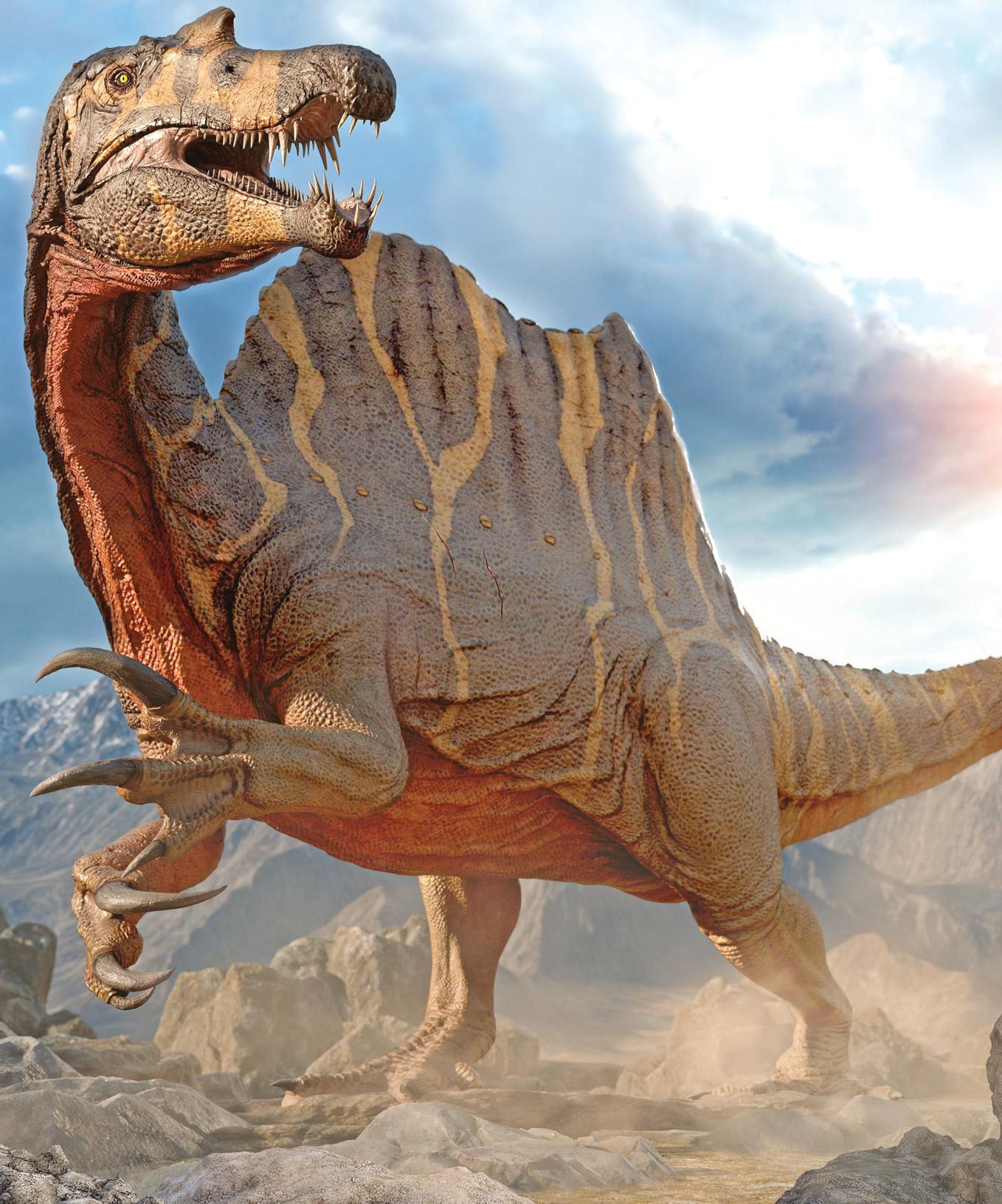Dawn of the dinos Dinosaurs weren’t always supersized. The first to evolve were rather diddy. They appeared around 250 million years ago, at the start of the Triassic period. At the time, the planet looked completely different. Instead of large chunks of land separated into continents, all the land was clumped together in one giant supercontinent called Pangea. Earth had also just experienced a mass extinction event (when species vanish much faster than they are replaced – usually about threequarters of all species over less than three million years). A colossal volcano or perhaps a meteor strike wiped out almost 90% of all animal life.
In this barren world, with most of the competitors off the scene, the first dinosaurs soon took advantage. These first Triassic dinos were the size of dogs, and looked a bit like crocodiles with long legs. By the start of the Jurassic period, 50 million years later, dinos had branched out.
image [https://cdn.magzter.com/1642519507/1726203999/articles/9aCzxiTwf1726212681335/1676726249.jpg]
They had evolved many new forms and occupied almost every habitat on Earth. Their legs now moved vertically underneath their bodies (rather than splayed out like a lizard). This allowed them to develop stronger leg muscles, move faster and begin to walk upright.
Getting bigger By the Cretaceous period – 145 million years ago – three main groups of dinosaurs had emerged: ornithischians (say or-nee-thiss-key-an) – plant eaters like Stegosaurus; theropods – two-legged meat eaters like T rex; and sauropods – long-necked giants like Diplodocus. Weighing in at 30 tonnes and 26 metres long, Diplodocus is perhaps the most well known sauropod. It was the giant of its time, but later on in the Cretaceous period, it would be dwarfed by truly humongous dinos called titanosaurs.
As the dinosaurs changed, so too had Earth. By the Cretaceous period, Pangea had broken apart, with the continents drifting towards their current positions. Plants were also evolving rapidly, with forests of mighty pine trees spreading far and wide. This created new habitats for the dinos to adapt to. It was in the lush pine forests of South America that the titanosaurs first appeared.
Meet the titans
The titanosaurs were so enormous, it’s hard to get a handle on their size. One way is to compare them to big things in today’s world – like a London bus, which is around 11 metres long and an adult African elephant, which weighs around eight tonnes.
image [https://cdn.magzter.com/1642519507/1726203999/articles/9aCzxiTwf1726212681335/2021792009.jpg]
Known simply as “The Titanosaur” since it was discovered in Patagonia, Argentina, in 2014, Patagotitan was given its formal name Patagotitan mayorum in 2017. At 37 metres long (3⅓ London buses) and weighing 70 tonnes (8¾ African elephants), it is likely to have been the biggest dinosaur ever, and would have been the world’s largest land animal ever. Patagotitan is so large that its reconstructed skeleton at the American Museum of Natural History pokes its head and neck out of the room and into the corridor.
image [https://cdn.magzter.com/1642519507/1726203999/articles/9aCzxiTwf1726212681335/2222279206.jpg]
Discovered in 1993, Argentinosaurus is the original titanosaur. Some palaeontologists (scientists who study fossils) think that it was even larger than Patagotitan, but since no complete skeletons have been found, their estimates are based on just a few bones of this species. Argentinosaurus could have grown to a mighty 40 metres long (3⅔ London buses) and weighed a staggering 100 tonnes (12½ African elephants).
image [https://cdn.magzter.com/1642519507/1726203999/articles/9aCzxiTwf1726212681335/2724622722.jpg]
By comparison, Spinosaurus – the largest meateating dino was just 14 metres long (1¼ London buses) and 7.4 tonnes (roughly equal to one African elephant). Even so, it was still likely a fierce predator and capable of taking down all but the largest “supersaurs”.
Living it large
For titanosaurs, size had many benefits. Firstly, large predators like Spinosaurus didn’t try to attack them as they were simply too big. Their long necks made munching trees easy.
These thumpingly heavy necks were full of air sacs that reduced their weight and also helped with breathing. Their heads were also tiny. This means that titanosaurs would have barely chewed their food, tearing off and swallowing vast quantities of plants, which were digested slowly inside their big bellies. Storing loads of food and water would also have helped them to survive periods of drought.
image [https://cdn.magzter.com/1642519507/1726203999/articles/9aC...


